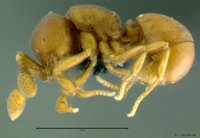Every time I sit down and try to identify ants, I have the same thought -- if only I could look at a whole bunch of ants at the same time. This seems like such a simple idea. Especially if you have no key and are trying to organize your ants into morphospecies. My identification process often goes something like this:
Okay, the hair on the head seems to be important, so I'll look at that. This ant has really long hair all over the place, we'll put you in group A. This ant also has really long hair all over the place. Great. Group A. This ant has really long hair all over the place, too, but it looks different somehow. Why? Is the color darker? I can't remember what the color of the first two ants were. I'd better go back and check. Okay the first ant's facial hair is kind of a yellow color. The second ant's facial hair is also kind of yellow, but only when you look at it at a certain angle. Maybe I should go back and check that first one again. What color was the third ant's hair? Aaahhh! I wonder if I've gotten any new email in the past ten minutes?
It is a constant exercise in going back and forth, looking at one ant, looking at another ant, going back and looking at the first ant, then looking at the second ant, then the third ant, then back to the first ant, etc. etc. I've seen ant folks put two ants together on a little square of foam and look at them together that way, but I find this difficult and inefficient.

By chance the other day I came across a comparison microscope. I had no idea these things even existed. Basically it is two microscopes connected together with a single set of eyepieces, so that you can (for instance) put an ant under one microscope, put another ant under the second microscope, and then look at both of them together in the same field of view at the same time. Brilliant. Of course I don't think anyone actually uses these things for entomology. They seem to be popular for use in forensics studies. But my question is, why not? How nice would it be to be able to do that? Very nice, is the answer. Of course they are not cheap and I can't afford one, but maybe there are those of you out there who could. Or who are already using this technology. If so, let me know. I would really like to know.
More recently I have been thinking about video microscopes, digital camera attachments, etc. There is great potential there for similar usefulness. Pop each of your (insert generic genus of terribleness) specimens onto the microscope, snap a few images of head, dorsal and side (for instance), and then line up your photos on the monitor and look at them all a once. Group the photos visually into morphospecies. You could quickly see differences that might take you awhile to figure out one by one. Some sort of mechanism to quickly click and drag images from group to group (or make a new group), change views, take notes, etc. would be nice. Obviously you would still have to go back and check stuff under the microscope but I am sure this would be much faster and less frustrating. Are people doing this? I don't really know of any software programs that might facilitate this, but it seems like it would be fairly easy.

I don't actually have a way to look at images from my microscope on the computer at the moment, but I am looking into it. There are a lot of options out there, mostly too expensive for me at the moment, and it is all very confusing. Does anyone have any suggestions? I actually just bought a Digital Blue QX5 Computer Microscope, but it has not arrived yet. I'm sure the images won't be super awesome but for $70 bucks it seemed worth the chance that it might be useful. I've read a lot about this microscope online and how even professional researchers are using it (it is marketed as a toy), but I haven't seen anyone actually using it for identifying. Anyone?
When I think about it, it seems crazy to me that myrmecologists are basically using the same technology that Darwin used to identify ants. Am I the only person who thinks this?




















